当前位置:
X-MOL 学术
›
Glob. Chall.
›
论文详情
Our official English website, www.x-mol.net, welcomes your
feedback! (Note: you will need to create a separate account there.)
Chitosan‐Functionalized Recycled Polyethylene Terephthalate Nanofibrous Membrane for Sustainable On‐Demand Oil‐Water Separation
Global Challenges ( IF 4.4 ) Pub Date : 2021-01-12 , DOI: 10.1002/gch2.202000107 Andrea Baggio 1, 2 , Hoan N Doan 3 , Phu P Vo 3 , Kenji Kinashi 4 , Wataru Sakai 4 , Naoto Tsutsumi 4 , Yasuro Fuse 5 , Marco Sangermano 6
Global Challenges ( IF 4.4 ) Pub Date : 2021-01-12 , DOI: 10.1002/gch2.202000107 Andrea Baggio 1, 2 , Hoan N Doan 3 , Phu P Vo 3 , Kenji Kinashi 4 , Wataru Sakai 4 , Naoto Tsutsumi 4 , Yasuro Fuse 5 , Marco Sangermano 6
Affiliation

|
The preservation of marine ecosystems is one of the most severe challenges at present. In particular, oil‐water separation from oil spills and oily wastewater is important. For this reason, a low‐cost, effective, and sustainable polymeric solution is in high demand. In this work, a controlled‐wettability membrane for selective separation of oil‐water mixtures and emulsions is developed. The nanofibrous membrane is prepared via a facile and cost‐effective electrospinning technique using environmentally sustainable materials, such as recycled polyethylene terephthalate and chitosan. The effect of different concentrations of chitosan on the morphology, chemical composition, mechanical properties, wettability, and separation performance of the membrane is evaluated. The membranes exhibited underoil superhydrophobic and underwater superoleophobic behavior, which is essential to perform the selective separation. In fact, the designed filter has competitive antifouling properties (oil intrusion pressure > 45 kPa) and showed high heavy‐ and light‐oil/water separation efficiencies (>95%) both for emulsions and immiscible mixtures.
中文翻译:

壳聚糖功能化再生聚对苯二甲酸乙二醇酯纳米纤维膜用于可持续按需油水分离
海洋生态系统的保护是当前最严峻的挑战之一。特别是,溢油和含油废水中的油水分离非常重要。因此,人们迫切需要一种低成本、有效且可持续的聚合物解决方案。在这项工作中,开发了一种用于选择性分离油水混合物和乳液的可控润湿性膜。纳米纤维膜是使用环境可持续材料(例如回收的聚对苯二甲酸乙二醇酯和壳聚糖)通过简便且经济高效的静电纺丝技术制备的。评价不同浓度的壳聚糖对膜的形貌、化学成分、力学性能、润湿性和分离性能的影响。该膜表现出油下超疏水和水下超疏油行为,这对于执行选择性分离至关重要。事实上,设计的过滤器具有竞争性的防污性能(油侵入压力> 45 kPa),并且对于乳液和不混溶混合物均表现出较高的重油和轻油/水分离效率(> 95%)。
更新日期:2021-01-12
中文翻译:

壳聚糖功能化再生聚对苯二甲酸乙二醇酯纳米纤维膜用于可持续按需油水分离
海洋生态系统的保护是当前最严峻的挑战之一。特别是,溢油和含油废水中的油水分离非常重要。因此,人们迫切需要一种低成本、有效且可持续的聚合物解决方案。在这项工作中,开发了一种用于选择性分离油水混合物和乳液的可控润湿性膜。纳米纤维膜是使用环境可持续材料(例如回收的聚对苯二甲酸乙二醇酯和壳聚糖)通过简便且经济高效的静电纺丝技术制备的。评价不同浓度的壳聚糖对膜的形貌、化学成分、力学性能、润湿性和分离性能的影响。该膜表现出油下超疏水和水下超疏油行为,这对于执行选择性分离至关重要。事实上,设计的过滤器具有竞争性的防污性能(油侵入压力> 45 kPa),并且对于乳液和不混溶混合物均表现出较高的重油和轻油/水分离效率(> 95%)。











































 京公网安备 11010802027423号
京公网安备 11010802027423号